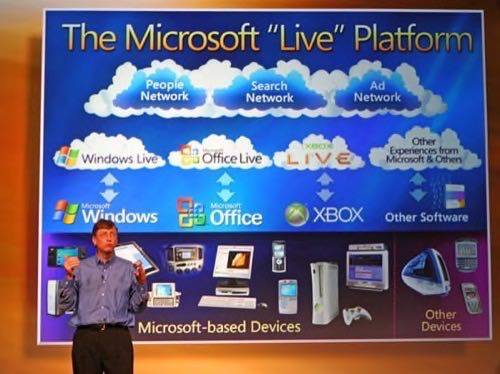Summary: My Day 1 impressions of Windows/Office Live are positive and I think Microsoft is taking
up the challenge of an increasingly Web-based software world, while at the same time
sticking to their desktop software knitting. I’m particularly intrigued by the Xbox 360
relationship and I think we’ll see a lot more multimedia coming out of Windows Live in
the future.
This morning Microsoft announced Web 2.0 ‘software as a service’ initiatives that went
beyond expectations. There is a lot to take in, so this post is me taking a deep breath
and trying to gather together the main points – from a Web 2.0 perspective that
is.
What was announced?
- Windows Live and Office Live services were the main offerings.
- Also an upgraded portal homepage at live.com (building
on the start.com technology), which will serve as the homepage for Windows Live
services. Like start.com, it has RSS and is AJAX-powered, but live.com adds email (an
enhanced AJAX version predictably named Windows Live Mail), IM, Voice over IP, and other
features to the mix. - A new advertising network: MSN adCenter (Robert
Scoble sees this as an important part of Live). - Microsoft Gadgets, which are third party
applications for Windows Live (Mike
Arrington likes ’em). - Mojo – Niall
Kennedy describes it as “a new collaborative editing program”. - Windows Live Messenger and Mail – upgrades to Hotmail and Messenger. Niall has a
good wrap.
Bill Gates gives us the outlook for Thursday – mainly fine, but clouds developing. Photo by Niall
Kennedy.

Some key words and phrases
- seamless experiences [meaning between the desktop and Web]
- software plus services
- Live (obviously…)
Some key points
- Windows Live and Office Live are separate products from the desktop Windows
OS and MS Office programs. In
the press release, they’re described as “compelling enhancements”. In Bill Gates’
speech, they were described as
“natural complements to Office and Windows.” Micheal
Gartenberg called them “extensions”. I think you get the picture – Live won’t replace
the desktop versions. I’d add: at least in the short to medium term. - It’s interesting that the branding is being aligned closely with Xbox Live, probably
Microsoft’s most successful media entertainment product over the past few years. Far more
successful than MSN. - Windows Live is the consumer product and will be supported by advertising, with
subscription and transaction-based services offered. - Office Live is described as “a new set of Internet-based services for growing and
managing a business online” and is specifically targeted at small businesses. However
the press release included this intriguing line: “Over time, the scope of Office Live
services will expand.” - Both Windows Live and Office Live hook into Microsoft’s system of developer and
partner networks. - Frequent software updates, which will extend to the Windows OS too.
Blog highlights
- Microsoft developer
Dare Obasanjo summarizes Windows Live as 1) web apps with rich UI (i.e. mostly AJAX),
2) smart desktop apps and integration between consumer apps, 3) The Web as a
platform. - Tim O’Reilly
pointed out that “Microsoft realizes the power of being able to build an integrated
experience across a hardware device, a software application, and an internet service”;
citing Xbox 360 (similar to the iTunes story Tim refers to all the time). - Heh, Nivi pointed out in the comments at
CrunchNotes that “live” spelt backwards is “evil”!! 🙂 Nivi says: “And Google is not
“evil”. Which means that Google = Microsoft.” Hee hee. - Some dissenting opinions: Danny Ayers
thinks this is “Plan C” and is doomed. Phil Pearson had trouble
subscribing to Scripting News. Russell Beattie sees Live as
“extensions to their desktop monopolies”.
Mary Jo Foley thinks there was “more posturing than substance in the Microsoft Live
unveilings”. - BetaNews asks: are
MSN’s days numbered? The party line in the press release is that MSN will continue to
provide “programmed content”, while Windows Live will provide “a personalized experience
with access to customized content and communications.” Dan Farber thinks Windows Live and MSN may
unite at some point in the future. My opinion: Microsoft has far too much invested in the
10-year old MSN
brand to drop it now, but I think eventually they’ll phase it out. - Alex Barnett
points out the value of looking at this news from “a historical perspective”. I agree
– in 5-10 years time we’ll look back on this and say that it was when Microsoft
embraced the Web as platform, or Web 2.0, or whatever it’ll be called in future. Just as
Microsoft
embraced the Internet in 1995, so they’re embracing the thing called Web 2.0 right
now. Mind you, perhaps Vista in 2006 will trump this news…
My Day 1 Analysis – Multimedia still to come
Whew! A lot of information to try and distil. My Day 1 impressions are positive
though. I think Microsoft is taking up the challenge of an increasingly Web-based
software world, while at the same time sticking to their desktop software knitting. I’m
particularly intrigued by the Xbox 360 relationship and I think we’ll see a lot more
multimedia coming out of Windows Live in the future.
Microsoft’s biggest product plays may still be to come – Internet TV and the Media
Centre, Xbox 360, video conferencing, mobile, and other Web-connected devices. These are all things that
require the hardware/software/Internet package – and of the 3 big companies, Microsoft
has shown itself to be the most capable at implementing that. Well, Google has the software/Internet integration all sorted, but they have shown us little in terms of hardware. Apple is of course the
acknowledged master, but they’re not on the same playing field as Microsoft, Google and
Yahoo. So I expect Microsoft’s Live strategy to really take off once they introduce more
multimedia to the mix.










